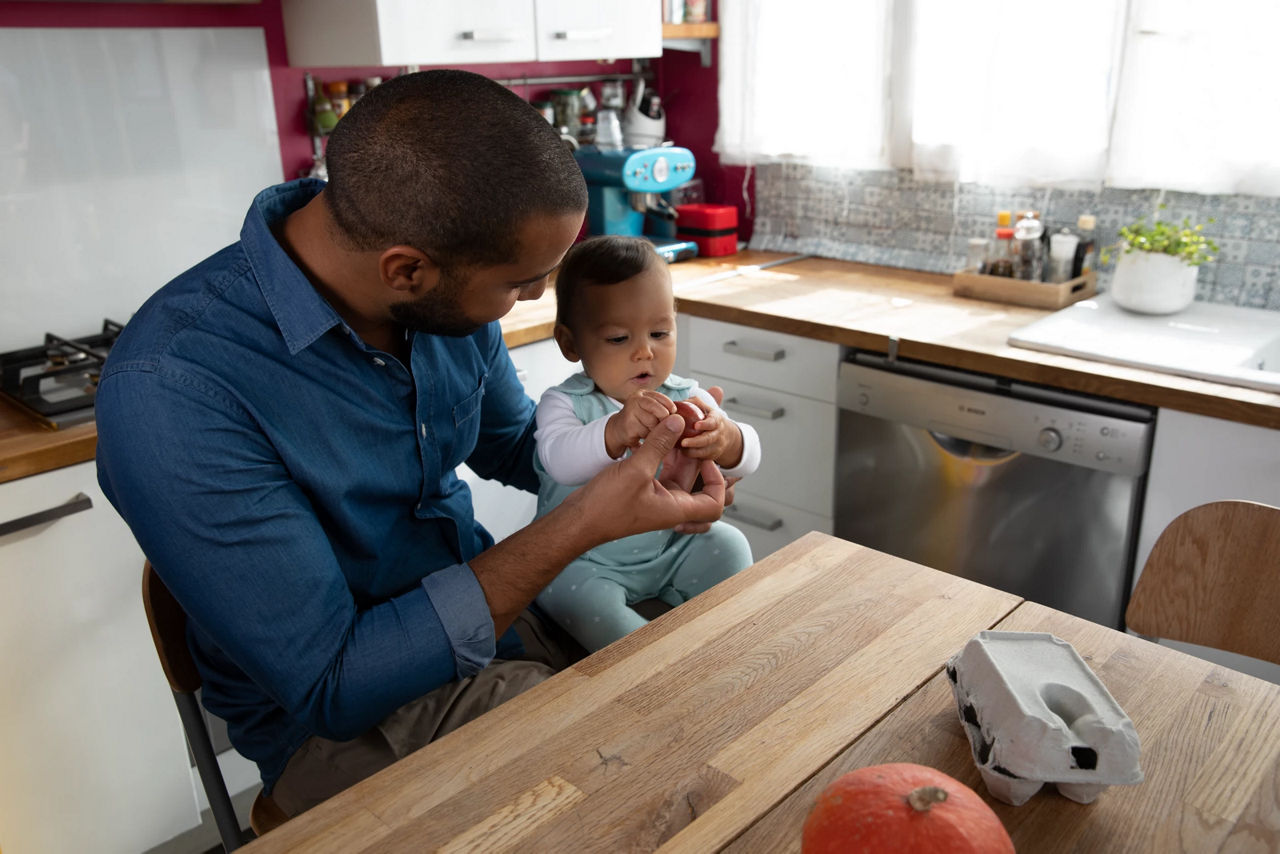Introducing your baby to a wide variety of foods when they start weaning will provide them with the nutrients they need to develop and grow healthily. They’ll be more likely to eat a varied diet later on in life too.
Baby foods: Introducing new foods & varied diet
Acquired tastes
Set them up with healthy habits for life

Introducing a variety of flavours and nutrients
Introducing your baby to a variety of new foods when they start weaning will help them get all the vitamins, minerals and nutrients they need to grow and develop healthily. It will also mean they are more likely to eat a similarly varied and balanced diet later in life.
Research has shown that mothers who said they’d given their children a variety of baby foods early on in life were less likely to report feeding problems as their children grew older. Furthermore, according to recent studies, a readiness to eat a variety of flavours has the important benefit of increasing the range of nutrients a child consumes1.
Babies are born with a preference for sweet foods, while other tastes like salty, bitter and sour have to be learned.
While babies are born with a preference for sweet foods, other tastes like salty, bitter and sour have to be learned. So by introducing your baby to as many new flavours as possible when they start weaning, you’ll be giving them the opportunity to acquire more new tastes and have a healthier, balanced diet as they grow up.
Of course, your baby may not like new foods straight away. Many parents will abandon a particular food if their baby rejects it just 2 or 3 times. Your baby may only decide they like a particular taste after several attempts so it’s worth persevering for as many as 8–10 times3. If your baby continues to reject a food, they may not like the food, or just may not be ready for it yet. Leave it for a week or two and then offer it again3.
It’s also a good idea to offer a variety of tastes during each meal and throughout the day: this has been shown to increase a baby’s acceptance of new foods and tastes. To encourage them, try to include some favourite foods that you know your baby will eat alongside new flavours as often as you can3.
 Perseverance can be necessary to get a baby to fully accept a new food
Perseverance can be necessary to get a baby to fully accept a new food
Growing up with fruit and vegetables
Fruit and vegetables are excellent sources of vitamins and minerals and should form a key part of a healthy, balanced diet. Despite this, most pre-school children in the EU consume below the recommended levels of fruit and vegetables2.
To encourage your baby to grow up eating plenty of fruit and vegetables, persevere in introducing these foods right from the start. Familiarity is key, with research consistently showing that one of the best approaches to getting children to willingly eat fruit and vegetables is to introduce them early. Now is the perfect time. So offer a wide variety of fruits and vegetables from the first stages of weaning and keep offering new tastes until your baby accepts them. As well as providing them with a wide range of nutrients, you will be building a solid foundation for healthy eating in the future.
If at first…
It’s more than likely that your baby will pull a face and refuse a certain type of baby food on their first attempt. More often than not, though, this face will be one of surprise and your baby is simply becoming accustomed to the taste, rather than rejecting it.
Persistence can be the key to helping a baby to fully accept a new food. Studies show that, unfortunately, most parents only offer a new food to their baby around 2–3 times3, and take any more refusals as a sign of distaste. Babies and toddlers are more likely to try new foods than older children, so it’s important to keep trying before the more stubborn refusals of childhood set in.
Practical advice on how to introduce new foods
It’s evident that giving your baby a variety of new tastes during weaning may lead to an increased readiness to accept unfamiliar flavours1. But sometimes theory is easier than practice.
Try following these tips to help your baby learn to love an array of flavours and tastes:
- Timing is important5:
- Do introduce new foods when your baby is relaxed, alert and happy – mid-morning is often a good time.
- Don’t introduce new foods when your baby is hungry for milk, or too full after a milk feed. Try offering food half way through their milk feed.
- Offer small amounts of a new food, and increase the quantity gradually4.
- Give your baby new food to play with so they can familiarise themselves with it before you try feeding it to them on a spoon. They may end up tasting the food anyway, by putting their fingers in their mouth.
- Let your baby hold the spoon if they want to and guide it into their mouth. Or give them one spoon to experiment with and use another to feed them.
- Make food fun. Be creative and keep your baby interested – make food shapes on their plate and let them enjoy the tactile aspect of their food by playing with it4.
- Ensure your baby sees you enjoying a variety of foods too. According to research, babies are more likely to eat foods that they see their mum eating and enjoying3.
- Try introducing more than one new food per meal to increase exposure to, and acceptance of, a variety of foods.
- Mix it up. Studies have shown that alternating foods from one day to the next can lead to more success than if you offer the same new food for three days in a row3.
- Explore different ways to cook one food. For example, you can mash, boil, roast or fry potatoes, and the texture, taste, colour and size of each is different.
- Don’t pressure your baby to try a new food. If they reject it, simply try again at a later time4.
- Family mealtimes are important right from the start. Children who eat with their families tend to enjoy a more nutritionally balanced diet compared to those eating on their own6. Try to arrange your baby’s highchair so that they are sitting with you when you eat, and start to share mealtimes together as soon as you can.
Related articles

Need some help?
You can get quick answers to common questions in our FAQs.
Alternatively, if you need help with general pregnancy or baby advice, or maybe on using or ordering our products - our expert team are always on hand to talk about feeding your baby.
- Gerrish JC, Mennella JA. Flavor variety enhances food acceptance in formula-fed infants. Am J Clin Nutr 2001;73(6):1080-5.
- G G Zeinstra, V Kooijman. The effect of three learning techniques on Dutch children's vegetable consumption [Online]. 2013. Available at: www.vivacongress2013.co.uk/wp-content/uploads/2012/09/VIVA_International_Congress_-poster_abstracts.pdf [Accessed April 2014]
- Nicklaus S. Children’s acceptance of new foods at weaning. Role of practices of weaning and of food sensory properties. Appetite 2011;57(3):812-5.
- Habeat. Vegetables and fruit. Help your child to like them [Online]. 2014. Available at: www.habeat.eu/media/file/BookletHabEat_Electronic%20version.pdf [Accessed April 2014]
- Caton SJ et al (2014) Learning to Eat Vegetables in Early Life: The Role of Timing, Age and Individual Eating Traits PLoS ONE 9(5): e97609. doi:10.1371/journal.pone.0097609
- Hammons AJ & Fiese BH. Is Frequency of Shared Family Meals Related to the Nutritional Health of Children and Adolescents? [Online}. 2011. Available at: http://pediatrics.aappublications.org/content/127/6/e1565.full.pdf+html [Accessed April 2014]
Last reviewed: 5th September 2016
Reviewed by Nutricia’s Medical and Scientific Affairs Team





?ts=1701285588461&dpr=off)